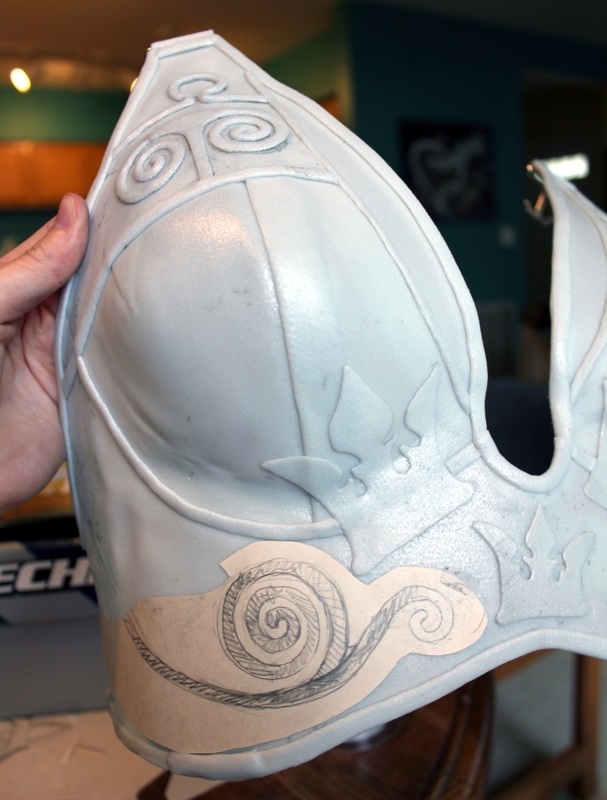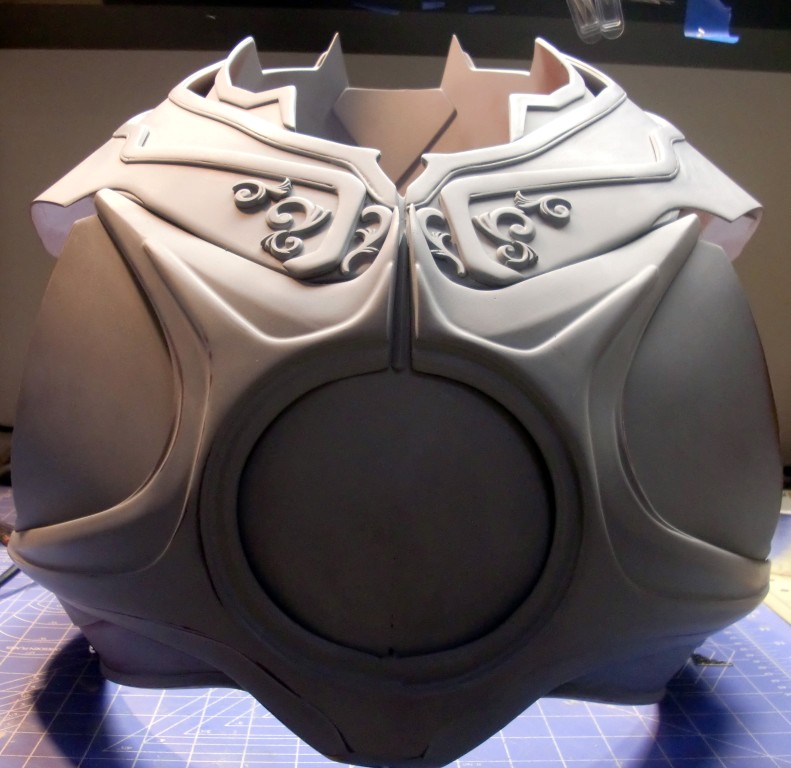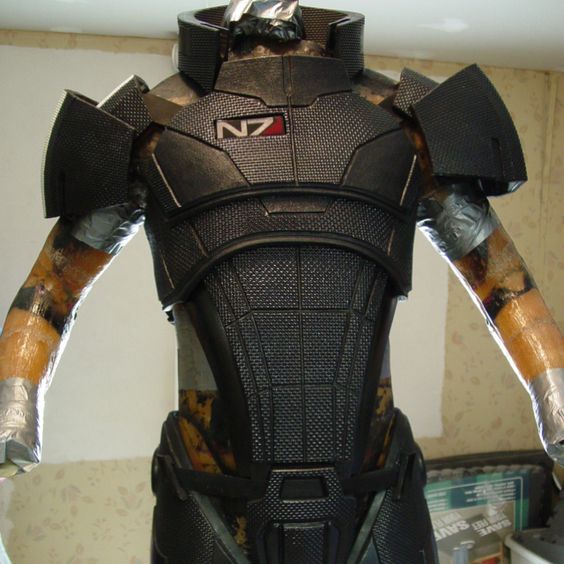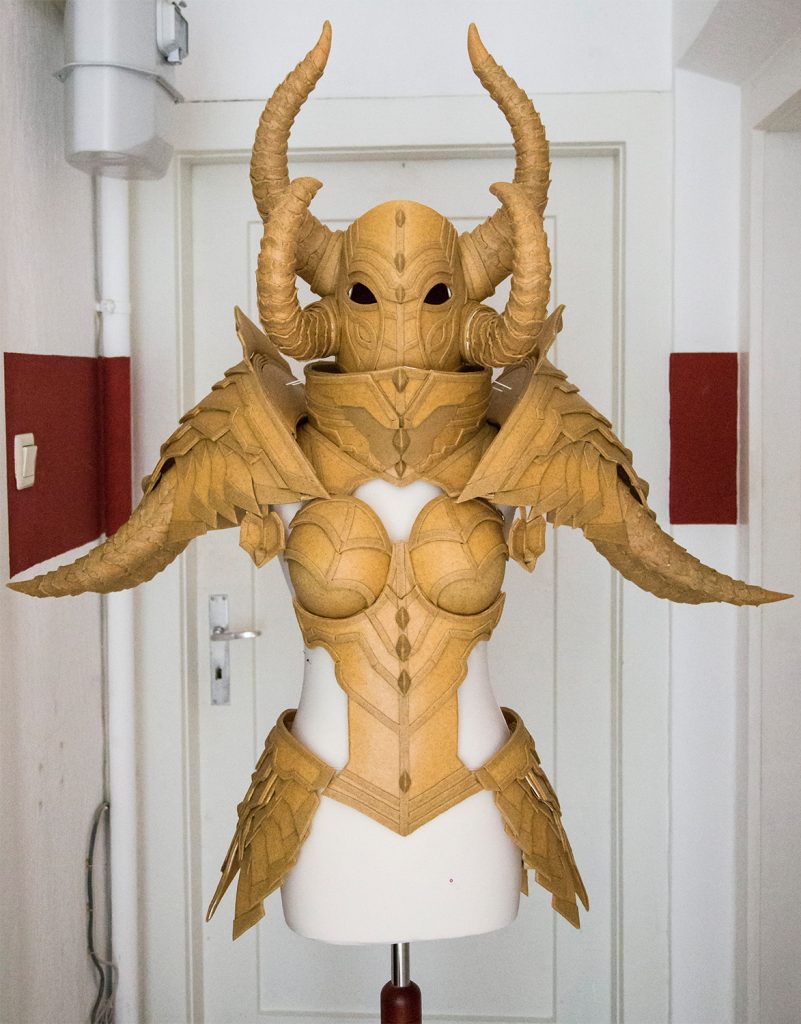Worbla vs. Wonderflex vs. Other Materials for Making Cosplay Armor
One question many new cosplayers ask is “what material is best for building cosplay armor and props out of?” There are many different products currently on the market for cosplayers to choose from and it can often be difficult and overwhelming to decide on one.
Craft Foam / EVA Foam
 Craft foam | Photo via: okie-dokie-cosplay.tumblr Craft foam | Photo via: okie-dokie-cosplay.tumblr |
 EVA foam | Photo via: overstock EVA foam | Photo via: overstock |
Craft Foam
- Comes by the sheet, by the pack of sheets, & in rolls
- Can easily be found in just about any craft store
- Can be formed into basic shapes using heat, but doesn’t do well with spherical shapes
- Smooth on both sides, but very porous (must be sealed before being painted –plastidip or resin, can use wood filler to fill in large gaps & gashes)
- Very cheap
- Flimsy, but can be strengthened with resin or a fabric and glue combo.
- Lighter in weight than other options
EVA Foam / Floormat Foam
- Sandable, but messy (respirator needed)
- Inexpensive
- Can be shaped (somewhat) with heat, but far less so than the thermoplastics.
- Inherently smooth, but porous (must be sealed before being painted –heat, plastidip or resin, can use wood filler to fill in large gaps & gashes).
- Typically leaves a lot of scraps/waste.
- Requires a retractable/box cutter knife –bit of skill required when cutting angles. Must continually resharpen blades.
- Requires glue for connecting pieces (contact cement –Barge).
- Tends to be lighter in weight than Wonderflex or Worbla.
- Can be bulky due to thickness.
Buy: Craft foam — EVA foam
Worbla (Worbla’s Finest Art)
Worbla (Worbla’s Finest Art)
- A thermoplastic that must be heated in order to be worked with.
- Can only be purchased online.
- Comes in various sized sheets.
- Becomes malleable when heated & retains its shape once it cools.
- Has one side that is the heat activated ‘glue side’ that allows it to stick to itself & other materials like foams.
- Scraps can be melted down into each other & be reused.
- Too much heating/reshaping/a difficult shape can lead to a bumpy and un-smooth surface.
- More expensive than craft foam & Wonderflex.
- When heated it can easily stretch to create complex curves & spherical shapes.
- Quite durable & stiff once cooled, but becomes quite limp when heated and typically needs a backing, such as craft foam, for support so that it doesn’t warp.
- Cannot be sanded.
- Does not have a smooth side (orange peel type texture), so must be primed/sanded before being painted if a smooth surface texture is desired.
- Can be cut with a pair of scissors.
- Tends to get heavy if creating large pieces, especially if layering the material using the sandwich method with craft foam.
 Worbla | Photo via: cosplaysupplies Worbla | Photo via: cosplaysupplies |
 Black Worbla | Photo via: worbla.cl Black Worbla | Photo via: worbla.cl |
 TranspArt | Photo via: eplastics TranspArt | Photo via: eplastics |
Black Worbla Compared to Regular Worbla
- Black worbla is thinner & lighter –easier to cut & heat up, but also slightly more weaker overall.
- The black color makes it easier to paint with metallic.
- Due to its smaller particles it’s easier to mold into details and stretches a lot easier.
- Much smoother surface –almost similar to that of craft foam.
- Doesn’t stick to itself as well.
- Less prone to air bubbles.
Worbla’s TranspArt Compared to Worbla (they’re technically different plastics)
- TranspArt has a higher working temperature & a shorter working time.
- Can pick up fingerprints & the texture from work gloves.
- Won’t become brittle or crack, it can stretch to a thin, almost brittle quality.
- Not completely clear –has a wavy appearance and show marks from the injection molding on the surface.
- More flexible, meaning it’s less rigid but still more resilient.
- Sticks to itself, but doesn’t really “glue” itself like Worbla’s Finest Art.
- Can paint the underside for a smooth, high gloss finish surface.
- It can be dyed.
- Harder to cut with scissors.
Buy Worbla — Black Worbla — TranspArt
Wonderflex
 Wonderflex | Photo via: cosplayshop.be Wonderflex | Photo via: cosplayshop.be |
 Wonderflex breatplate | Photo via: projectfancy Wonderflex breatplate | Photo via: projectfancy |
- A thermoplastic that must be heated in order to be worked with.
- Can only be purchased online.
- Comes in various sized sheets.
- Becomes malleable when heated & retains its shape once it cools.
- Wonderflex sticks to itself and other similar materials.
- Scraps cannot really be melted down into each other for reuse given the mesh backing. (although with a little effort, this mesh can be removed so that scraps can be better used -thanks Brian!)
- Has one smooth side that does not necessarily have to be primed/sanded for paint.
- Like craft foam, it’s hard to make spherical shapes without using darts since it has a mesh on one side.
- Too much heating/reshaping/difficult shapes can lead to a bumpy and un-smooth surface
- Moderately expensive, but less so than Worbla.
Buy Wonderflex
Sintra (PVC Foam Sheet or PVC Foam Board)
 PVC board | Photo via: signcraftersupply PVC board | Photo via: signcraftersupply |
 Sintra chestplate | Photo via: 405th Sintra chestplate | Photo via: 405th |
- PVC foam that must be heated in order to be worked with.
- Retains its shape immediately after heating, even when still warm.
- The material can be sanded.
- Cheaper than both Wonderflex and Worbla.
- Has a smooth surface that generally doesn’t require prep before being painted.
- Using PVC glue to attach pieces is typically recommended.
- Comes in various thicknesses.
- Typically strong/durable enough on it’s own and doesn’t need to be layered or backed liked Worbla and Wonderflex.
- A respirator is recommended when heating this material.
- Heats at a higher temperature than Worbla or Wonderflex.
- Can create shaped curves (with patience and care) but typically recommended for hard edges, lines, and polygons.
- Lighter in weight than Worbla or Wonderflex.
- Requires a box cutter (or scroll saw) to be cut.
Buy Sintra
While I personally lean more towards Worbla and craft/EVA foam myself, I’d recommend getting your hands on a couple different types of materials and playing around with them. This way you can figure out for yourself what you like best. Remember, you can use a couple different materials for a single build (many people will use Worbla and Sintra together in a single project, for instance, using each material based on their strong-points.
No matter which direction you decide to go, remember that patience and practice are you best friends!
How to add details & finishing touches to cosplay outfits



 EVA foam armor | Photo via:
EVA foam armor | Photo via:  Worbla armor | Photo via:
Worbla armor | Photo via: 
Great article. I love how many photos you used. Very informative. I am going to get into armor building this summer. YIKES.
So glad you found the article helpful Sadie! Let me know if you have any other questions. Armor building is a lot of fun and very rewarding…just remember to have patience and start with a great pattern.
We enjoyed reading your article….nice job. As the father of WONDERFLEX and FOSSHAPE….I’m amazed as to the number of new thermoplastic-like materials now available. Just a couple of comments relative to WONDERFLEX…..it takes some time and effort, but that mesh or fabric support can be peeled off when heated, so you can better utilize scraps. Also, WONDERFLEX is only produced and offered in one thickness. Thanks to The Nifty Nerd.
Thanks for stopping by and providing some input Brian! I was unaware that the mesh backing could peeled away -that’s great to know!
And oops -that various thicknesses line was not suppose to be attached to the Wonderflex section. Thank you for catching that. I’ve updated the post 🙂
As far as removing the Mesh or Fabric from the back of Wonderflex, I have found using a pin or needle to lift the first few threads the best way to get started then it’s a simple but careful peel.
Great tip -thank you Dee!